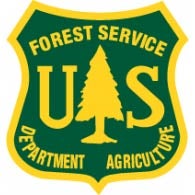Agenda2020
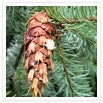 Summary of Agenda2020
Summary of Agenda2020
I. Wood Quality Study
II. Introduction
Wood stiffness is the most important property of structural lumber. Wood characteristics are particularly important for coastal Douglas-fir, which is used primarily for dimension lumber and is renowned for its high strength and dense wood. Maintaining wood stiffness and strength are essential for ensuring Douglas-fir?s niche in the domestic and international timber markets. Because juvenile wood is less stiff than mature wood, the quality of Douglas-fir lumber may decline as stand rotation lengths decrease. Unfortunately, destructive testing, in which trees are felled in order to obtain wood quality measurements, has been the standard procedure for evaluating wood stiffness and strength. Therefore, the timber owner does not have a reliable way to assess the value of the final product prior to harvest. Post-harvest methods for measuring wood strength, such as visual grading and machine stress rating, are also not ideal.
Wood traits of coniferous species are typically highly heritable, and may be improved through selection and breeding. Because of the importance of wood quality to timber value, and the inadequacy of current methods for assessing wood quality prior to harvest, a number of agencies within the region are interested in studying the genetics of wood quality. At the 2004 PNWTIRC Annual Meeting, members approved the development of a research proposal to study the genetics of Douglas-fir wood stiffness and strength. For example, members would like to know whether nondestructive tools can be used to assess wood properties in their tree improvement programs. The University of Washington Stand Management Cooperative (SMC) was recently awarded a USDA Agenda 2020 research grant to investigate non-destructive evaluation of Douglas-fir wood quality. At the same time, the USDA Forest Service Pacific Southwest Research Station (PSWRS), USDA Forest Service Pacific Northwest Research Station (PNWRS), University of California Davis (UC Davis), and the PNWTIRC were awarded a USDA Agenda 2020 research grant to study genes that influence wood property traits in Douglas-fir. The Wood Quality Study was designed to address these and other questions in collaboration with the SMC, PNWRS, and PSWRS.
III. Accomplishments for 2004-05
IV. Project development
Direct measurement of wood stiffness and strength requires destructive testing. Therefore existing, high-quality genetic tests that are about 20 years old and due for thinning are ideal for this project. Glenn Howe and Marilyn Cherry visited numerous first-generation progeny test sites and cooperators in Washington and Oregon during the fall and winter of 2004 to evaluate the suitability of each series for inclusion in the proposed study. Potential series were narrowed down to Olympic Resource Management’s Port Gamble series and its associated clonal seed orchard in Washington, and the BLM’s Breeding Unit 13 series and its associated clonal seed orchards in Oregon. A research proposal was developed and presented to PNWTIRC members at the 2005 Annual Meeting. The four main objectives of the study, and approaches for addressing each objective, are described below.
Objective 1: To estimate potential genetic gains for direct measures of Douglas-fir wood stiffness (modulus of elasticity, MOE) and strength (modulus of rupture, MOR)
Direct measures of MOE and MOR from lumber will be used to estimate genetic parameters and heritabilities, and to predict genetic gains for each trait. We will also examine the genetic correlations among traits. The direct measures of MOE and MOR will be derived from a subsample of the Port Gamble progeny test (50 families, 8 trees per family). Lumber (2? x 4? x 8?) will be cut from the logs using a portable sawmill, obtaining as many pieces of lumber as possible from each log. The lumber will be kiln-dried, and tested. MOE and MOR will be estimated using bending tests in which force is applied to the middle of a supported beam.
Objective 2: To determine which indirect measurements of MOE and MOR are useful for improving wood stiffness in operational tree improvement programs, and to estimate the relative gain efficiencies of the various indirect measures tested
The use of wood quality traits in tree improvement programs requires the use of rapid measurement techniques that are preferably non-destructive and applicable to small trees. Various indirect measures of wood quality show promise, but data on Douglas-fir are limited. Therefore, it would be valuable to evaluate indirect measures of wood quality relative to direct measures of the same traits. Wood quality traits are difficult and expensive to measure directly compared to traits such as height and diameter, but indirect methods are becoming increasingly available. Indirect measures of MOE include various acoustic techniques using tools such as the Fibre-gen Director ST300TM, hereafter referred to as the ST300, and Fibre-gen Director HM200TM, hereafter referred to as the HM200. The ST300 is designed to be used on standing trees, wereas the HM200 is used on logs.
We will calculate genetic correlations between (1) the direct measures of MOE and MOR from lumber pieces and (2) indirect estimates of MOE obtained using the ST300 and HM200. These analyses will be used to calculate relative gain efficiencies and determine whether indirect and/or nondestructive methods of evaluating wood stiffness and strength will be useful in genetic tests. If genetic correlations and relative gain efficiencies are high, we will then be able to recommend nondestructive test procedures for tree improvement programs.
Objective 3: To determine whether the wood properties of seed orchard parents can be used to predict the wood properties of their progeny
It may be possible to use parents in clonal seed orchards to efficiently and cheaply estimate the wood quality of their progeny. This would be desirable because seed orchard trees are normally easier to access and measure, but are also open-grown and hence more likely to have larger growth rings and different wood properties than trees growing in progeny tests. The ability to measure fewer trees in an easily accessed seed orchard would be valuable because of the high costs of measuring wood quality traits. Therefore, we will compare genetic parameters and relative rankings of wood quality traits between clonal orchard parents and their progeny. We will determine whether gains in progeny wood quality can be predicted via indirect selection of the parents. Futhermore, we will estimate heritabilities using parent-progeny regression and compare these values to heritabilities derived from analyses of open-pollinated progeny tests.
Initially, analyses will focus on wood specific gravity and acoustic measures of wood stiffness. However, because we will retain the wood disk samples, it will be possible to analyze other wood properties in the future.
Objective 4: To identify molecular genetic markers that are associated with desirable wood properties
Wood quality is one of the key areas of interest for gene association mapping. A population genomic approach called association mapping can now be used to identify genes responsible for phenotypic differences in wood properties. This may allow promising genotypes to be selected without having to grow and measure them in long-term field tests.
In a previous study of loblolly pine (Groover et al 1994; Sewell et al 2000, 2002; Brown et al 2003), the number, effect size, and approximate location of quantitative trait loci (QTL) controlling wood properties were estimated, and significant associations between candidate genes and wood properties were detected. We will now verify these associations in a second species, Douglas-fir. Verification of these associations in a second conifer species will provide convincing evidence that the individual genes controlling conifer wood properties have been identified.
Wood quality is one of the key areas of interest for gene association mapping. A population genomic approach called association mapping can now be used to identify genes responsible for phenotypic differences in wood properties. This may allow promising genotypes to be selected without having to grow and measure them in long-term field tests.
In a previous study of loblolly pine (Groover et al 1994; Sewell et al 2000, 2002; Brown et al 2003), the number, effect size, and approximate location of quantitative trait loci (QTL) controlling wood properties were estimated, and significant associations between candidate genes and wood properties were detected. We will now verify these associations in a second species, Douglas-fir. Verification of these associations in a second conifer species will provide convincing evidence that the individual genes controlling conifer wood properties have been identified.
Candidate genes for adaptive traits and wood properties have already been identified in Douglas-fir. More than 11,000 expressed sequence tags (ESTs) were sequenced, and single nucleotide polymorphisms (SNPs) in candidate genes for adaptive traits and wood properties were discovered as part of a completed USDA-Forest Service Agenda 2020 project (Phase I; Neale 2002). These sequences are available at GenBank and TreeGenes. Additional ESTs have been added to this database, and the expanded database is now being used to identify additional wood property candidate genes. SNPs in these genes will be used for genotyping and for testing wood property associations in Douglas-fir.
Foliage samples from seed orchard ramets will be used for DNA isolation. Samples will be forwarded to UC Davis for genotyping of wood quality candidate genes. Associations between wood quality phenotypes and candidate genes found in loblolly pine will then be tested using our Douglas-fir samples. We will test for associations between the wood quality genotypes of the seed orchard parents and the wood quality phenotypes of the seed orchard parents and their progeny.
Expected Outcomes of the Wood Quality Study
- Obtain information that can be used to develop optimal strategies for improving Douglas-fir wood quality and value
- Identify wood properties that can be incorporated into breeding programs to improve wood stiffness and strength
- Make recommendations for using nondestructive testing to improve wood quality in tree improvement programs
- Make recommendations for using wood properties of seed orchard parents to predict the wood properties of their progeny
- Identify molecular genetic markers associated with desirable wood properties in Douglas-fir that may be used by Douglas-fir breeders and gene resource managers
- Determine whether associations between wood quality phenotypes and candidate genes detected in loblolly pine are also present in Douglas fir
V. Project implementation
The study proposal was approved by members at the 2005 Annual Meeting. Work commenced at the Hood Canal Seed Orchard in Washington in March 2005 when the orchard was rogued (Figures 3, 4, 5, and 6). Specific gravity, tree ring counts, and acoustic velocities of 17 butt logs were measured using the HM200 and ST300. At the same time, foliage was collected for the candidate gene work.
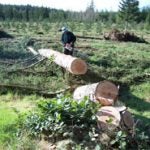
Figure 3. Logging the Olympic Resource Management Hood Canal Seed Orchard, March 2005.
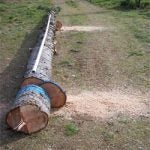
Figure 4. Removing wood disks from both ends of a butt log 17 butt log cut above the graft union) at the Hood Canal Seed Orchard.
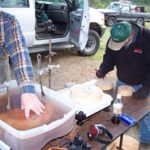
Figure 5. Collecting data from wood disks at the Hood Canal Seed Orchard.
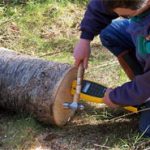
Figure 6. Measuring acoustic velocity of each log at the Hood Canal Seed Orchard.
VI. Plans for 2005-06
The candidate gene analyses are progressing. A new PNWTIRC graduate student, Vikas Vikram, will be working on a portion of this study for his Master?s thesis. Plans are being made to harvest the Olympic Resource Management Port Gamble progeny tests. During the summer, trees will be measured for dbh and standing tree acoustic velocity. Harvesting will commence in the fall of 2005. Nine-foot butt logs will be measured for log acoustic velocity and wood disks will be measured for specific gravity and ring count traits. A subsample of logs from each of 50 families per site will be milled into 2 x 4 lumber, and tested for MOE and MOR using bending tests.
Download About the Agenda2020 Project PDF
Members
Participating Organizations
![]()

